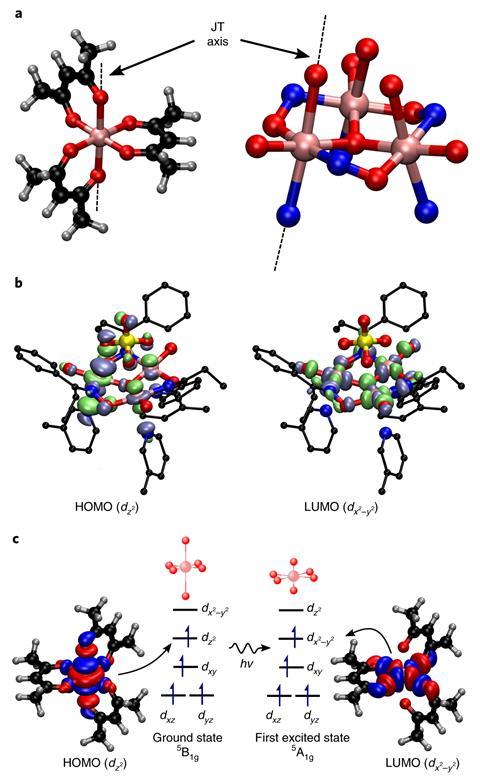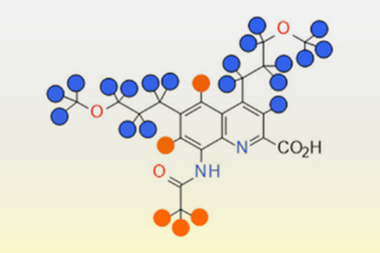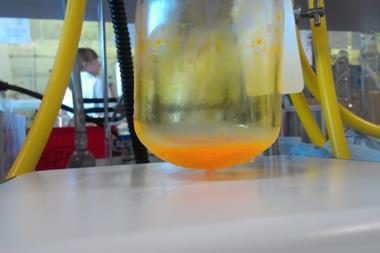Clever chemistry could help computers cram even more data onto their hard drives. Rachel Brazil reports on single-molecule magnets
This year we are likely to see the first ‘exascale’ computer – able to carry out at least 1018 operations per second. The computer itself will be the size of 10 tennis courts, but it will require the smallest electronic components possible. IBM, for example, have just announced their latest chip will have 333 million transistors per square millimetre - that’s a footprint of 2nm for each transistor. The size of the other crucial part of computer technology, magnetic memory, is not shrinking at the same rate, however. The current state of the art technology will store a single bit of data in a dozen or so magnetic grains, each around 3nm. Memory is becoming the weakest link in the race to faster and more powerful computing.
Enter chemistry and the single molecule magnet. Could the current solid magnetic grains be replaced by a single molecule less than 1nm across , whose magnetic state could be imprinted with binary data? Until the last few years this seemed clearly in the realms of science fiction, but in 2017 two groups published ground-breaking results, showing that a single dysprosium complex could be magnetised and briefly retain its magnetic state at up to 60K. Although that temperature threshold is very cold, it is tantalisingly close to being reached using liquid nitrogen, rather than colder temperatures which require expensive liquid helium cooling. This is only one small step along the road to molecular-scale magnetic memory, but some research groups across chemistry and physics are starting to think seriously about how it might be done.
‘You can look at the single molecule magnet as an individual paramagnet that’s the size of the molecule,’ says David Mills from the University of Manchester in the UK, who heads one of the research teams that reported the first ‘high-temperature’ single molecule magnet (SMM). SMMs are generally coordination complexes with unpaired electrons that can switch between two opposite orientations of their magnetic moment, creating magnetic bi-stability below a certain ‘blocking temperature’.
‘You apply magnetic fields, and the molecules align [their spins] with the magnetic field,’ explains Mills. Depending on the direction of the field this provides two potential states that could be used to encode binary data. The molecules must show magnetic hysteresis, which means that even when the external magnetic field is removed, they stay magnetised due to the energy barrier between spin orientations. ‘The idea is that in the future we should hopefully [be able to] address one molecule at a time for these data storage applications,’ he adds.
Designing magnetic molecules
The SMM field began to grow in the early 1990s, with magnetic bi-stability first noted by chemists at the University of Florence, Italy, in a 12 manganese cluster known as Mn12 -acetate made up of eight Mn(iii) and four Mn(iv) ions. The magnetic hysteresis observed below 4K was attributed to the magnetic coupling of the unpaired d-electron spins on each of the transition metal ions and the large energy barrier to changing spin produced by the ligand environment. ‘From that point onwards, the field basically exploded,’ says Richard Layfield, a chemist at from the University of Sussex in the UK, whose group synthesised what is currently the highest temperature SMM.
The problem with these large transition metal clusters is that the magnetic states were only retained at temperatures in the single digits Kelvin. Otherwise, explains Mills, ‘they relax to a random state quite easily when you remove the magnetic field’. So 10 years ago attention turned to single lanthanide ion complexes (terbium and dysprosium), because the hunch was that they would have superior magnetic properties. ‘Everything was about maximising the spin on the molecule [with large transition metal clusters],’ says Layfield. ‘Then it became apparent that it probably was the anisotropy and not the number of unpaired electrons that was the important thing.’
Magnetic anisotropy describes whether a molecule has an intrinsically preferred direction for how spins line up in a magnetic field. ‘When it comes to single ion anisotropy, the lanthanides are pretty much unbeatable throughout the periodic table,’ says Layfield. Because lanthanides generally bond ionically rather than covalently, they retain the directionality of their f-electron orbitals and therefore exhibit high magnetic anisotropy. The first example came in 2003, with a lanthanide sandwiched between two phthalocyanine ligands. ‘The fact that one lanthanide could do this, compared to [clusters requiring] multiple d transition metals, quickly turned a lot of heads in the field,’ recounts Mills.
They key was then to design a complex with a spatial distribution of ligands that would optimise this magnetic anisotropy – and that turned out to be by concentrating the ligands axially, above and below the metal ion, a concept first suggested in 2011. The interaction with the ligands’ negative charge causes splitting of previously degenerate energy levels, and creates the largest energy gap between magnetic states which prevents magnetic relaxation at higher temperatures. Numerous ‘double-decker’ complexes were designed with large aromatic ligands to block access to additional coordination. But by 2011 the highest blocking temperature was still only 14K
Dysprosium became known as the best performing lanthanide ion and seemed the best bet for a higher temperature SMM. ‘The consistent picture that was emerging was that if you have a dysprosium 3+ ion, sandwiched between two cyclopentadienyl ligands, that is the basis of single molecule magnetic properties. But if you include additional ligands, elsewhere in the molecule, that attenuates the [magnetic] properties,’ says Layfield.
With this in mind, the race was on to synthesise a double-decker dysprosium complex with only two axial cyclopentadienyl ligands, and no equatorial ligands to reduce the anisotropy. Mills and Layfield, both at the University of Manchester at that time, took up the challenge, both using cyclopentadienyl ligands substituted with three tertiary butyl groups to increase the steric hindrance and prevent the coordination of other ligands. In 2017 they both succeeded in making and publishing details of this complex leading to significant controversy and an internal investigation by the University of Manchester. It has now been acknowledged, in a corrigendum to Layfield’s paper, that Mills and his Manchester colleague Nick Chilton submitted their manuscript over a month earlier.
Both groups went via a triply coordinated dysprosium cation, with an additional chloride ligand. But a question still remained, according to Mills. ‘How could you get that halide off [from] around the equator, and replace it with a weakly coordinating anion?’ His group did this using a highly electrophilic silylium cation, producing a sandwich complex which exhibits magnetic hysteresis at up to 60K.
In 2018 Layfield’s group, by now at Sussex, synthesised another dysprosium complex, this time with the ion sandwiched between a smaller pentamethylcyclopentadienyl ligand and a larger penta-iso-propylcyclopentadienyl ligand. This showed magnetic hysteresis at up to 80K – the highest temperature yet. ‘The refined mixed-ligand approach allows the SMM properties to be improved substantially, essentially because the molecule can get closer to being linear and the two ligands can get closer to the metal, providing a stronger crystal field,’ explains Layfield.
‘15 years ago, no one dreamed of a single molecule magnet that could actually work at a reasonable temperature. This was a very important milestone,’ says chemist Lucie Norel from the University of Rennes in France. But before you throw away your solid-state hard drive, it is worth considering the task ahead: what has been coined the trilemma of magnetic recording – readability, writability and stability – and getting all three isn’t easy. For SMMs this means molecules with magnetic anisotropy and very long relaxation times. ‘For the best performing systems, at very low temperatures, the relaxation time is on the order of a day,’ says Layfield – clearly not yet long enough for storing data. Plus the complexes synthesised by Mills and Layfield are air-sensitive, so not easy to handle.
Making a device
This hasn’t stopped other researchers exploring how SMMs could be used in data storage devices. ‘If you’re going to make a device, you need to deposit these things uniformly on the surface, [and] you need to do so in a manner that keeps them chemically intact,’ says Layfield. Several groups have attempted to do this using methods like electrospray ion beam deposition – a high-voltage spray-coating process. But this is unlikely to allow one molecule to be read at a time, which would provide the highest possible memory density. The deposition process itself often leads to a loss of the molecule’s magnetic properties. ‘You design an SMM, such as the beautiful dysprosocenium systems, and then you put them on surfaces and you change a bit of geometry and all your properties are gone,’ says Christophe Copéret, a surface chemist at ETH Zürich in Switzerland.
Copéret and post-doctoral researcher Maciej Korzynski have managed to immobilise a dysprosium SMM and even improved its magnetic relaxation time compared to its precursor. They started with 20nm silica nanoparticles which were partially dehydroxylated to create an array of spatially separated silanol anchor sites. They reacted the surface with a dysprosium ion coordinated to one cyclopentadienyl moiety and another large ligand. ‘We just did a very simple exchange reaction where we consider the surface as a ligand,’ explains Coperet, so the complex is tethered via a siloxide group. Because the negative charge on the siloxide is more localised than the large organic ligand it replaced, it increases the axial electron density, and therefore the magnetic anisotropy, ‘in a way you have an ideal configuration to make an SMM,’ adds Copéret.
The relaxation properties of this system are still far from the results achieved by Mills and Layfield, but Copéret is not too concerned. ‘I think we have found a concept that shows that we can make a better SMM on a surface … but we have not broken the big problem, which is, can we make it work at room temperature.’ This approach shows how individual SMMs could be utilised to store a higher density of information than the current state of the art (1.2 terabits per square inch). ‘If we imagine a calculation where each of those dysprosium sites that we create can encode one bit of information, then we actually ended up being at least one order of magnitude higher in terms of density of bits on the surface, which is actually quite exciting,’ says Korzynski.
The speed of light
Another feature needed for magnetic memory is the ability to switch the magnetic properties on and off, to erase and overwrite data. Norel, along with Rennes colleague Stephane Rigaut, has been investigating how light could enable remote, rapid and energy-efficient switching of lanthanide SMMs. ‘Our idea is to use light irradiation and photochromism to modify the magnetic behaviour of our complexes,’ explains Norel.
They used the photochromic molecule spiropyran – a pyran linked to a second ring system that shares one of its carbons. The pyran ring opens up to form merocyanine forming a phenolate oxygen. Norel and colleagues synthesised a lanthanide complex, with a tetradentate ligand containing the merocyanine isomer which showed magnetic hysteresis at 2K. ‘On irradiation [with visible light], you replace this oxygen–lanthanide bond by an oxygen–carbon bond, which means a huge change in the coordination sphere of the complex,’ says Norel, ‘We saw the change in coordination occurring upon photoswitching,’ but so far the alternative isomer has not proved stable, she adds, and the complex collapses rather than shifting to a non-magnetic complex. They are still developing the concept.
Photochemist Olof Johansson from the University of Edinburgh, UK, is pursuing an allied approach. He is hoping to use femtosecond laser pulses to manipulate the magnetisation of an SMM. ‘About 20 years ago, people found that when you photo-excite some transition metal complexes, the spin changes almost instantaneously within hundreds of femtoseconds,’ says Johansson. ‘The interesting step would then be to study single molecule magnets where the spin plays a major role in their [magnetic] properties.’ This has the potential to produce not only high-density memory, but memory that operates perhaps 1000 times faster than at present.

Johansson collaborated with synthetic chemist Euan Brechin, also at the University of Edinburgh, to see how manganese coordination clusters would respond to such laser pulses. The clusters consist of magnetically anisotropic manganese(iii) ions arranged in triangles, bridged by oxygen and nitrogen atoms. For an octahedral metal ion, laser excitation can change the shape of the molecule, based on modifications to the crystal field. However, from spectroscopic studies at room temperature the team found that Brechin’s bridged complexes were constrained and so undergo a collective vibrational motion as the molecules try to adjust their shape in the excited state. ‘They were all moving in a collective motion along one axis, which is the anisotropic axis – that was quite exciting,’ says Johansson. ‘When the anisotropy axis is less elongated during the vibrational motion, it will be easier to flip the spin using an external field.’ If the whole process could be controlled by light it would provide an ultra-fast method for writing magnetic data.
This idea also has some parallels to heat-assisted magnetic recording (HAMR), the latest commercial magnetic memory technology developed by data storage company Seagate. It uses grains of magnetic materials that are smaller than in conventional memory but more resistant to changing their magnetic state. Therefore to write data the grains need to be first heated up with a laser. ‘That means they can squeeze everything much closer together so that they can increase the data storage density,’ explains Johansson. Using a laser to control the magnetic anisotropy of an SMM could provide an analogous method on a molecular scale.
So far Johansson’s team has shown they can instantaneously change the electronic structure and shape of the molecule, but are yet to test the magnetic properties at the required low temperatures. They expect this will provide a model for quicker magnetic switching, and plan to look at other complexes, including those containing lanthanide ions.
Higher temperature SMMs?
Of course, the problem that still remains is how to get magnetic properties at higher temperatures. With the current highest temperature SMM at 80K, ‘you couldn’t imagine having a device with SMMs in your pocket’, says Mills. ‘But you could imagine [it at] a very large data centre.’ Even so, chemists are still thinking of strategies to raise their working temperatures. A big focus is on the types of ligands coordinated to the central lanthanide. One route when using cyclopentadienyl ligands would be to change the substituents on the ring and see the effect on the magnetic behaviour, ‘but eventually, that just becomes stamp collecting’, says Layfield. Another is to look for more rigid ligand molecules. ‘A lot of the things that cause fast relaxation are down to molecular vibrations,’ says Mills, so the more rigid the ligand, the higher the magnetic relaxation time will be.

At the other end of the spectrum Norel and colleagues have synthesised one-dimensional chains of dysprosium complexes replacing one of the large ligands with just a fluoride ion. ‘To have good SMM properties, you would [ideally] like to have dysprosium and two point charges on an axis. A point charge in chemistry does not exist but we have a fluoride ion, which is quite close,’ she explains. Her complex also needs an opposite bulky organic hexadentate ligand to keep the axial coordination. Its magnetic anisotropy is not as large the dysprosium sandwich compounds, but ‘they are air stable and we can do more chemistry with them – we can use them as a building block to make other type of materials – for instance, photoswitchable magnetic materials’, says Norel.
‘As long as people just keep making things and study them … we will discover better SMMs, it’s just a matter of time,’ says Mills.’ And they will probably look very different to the SMM that are the current leading examples today.’ But there is competition from an even smaller competitor. In 2017, scientists at IBM showed they could use holmium atoms as magnetic recorders, absorbed onto magnesium oxide film and forming highly stable magnets up to 45K. So it may be that even molecules will prove too large, and future magnetic memory devices will store each bit of data in a single atom.
Rachel Brazil is a science writer based in London, UK
















No comments yet